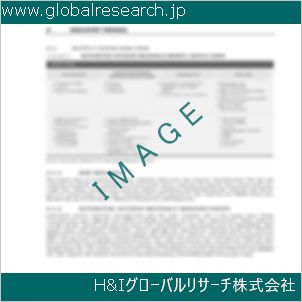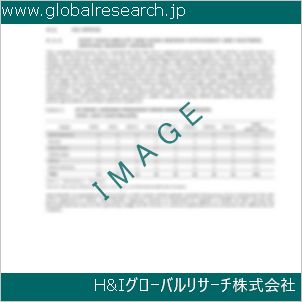目次
第1章. グローバル自動車用バッテリーセンサー市場レポートの範囲と方法論
1.1. 研究目的
1.2. 研究方法論
1.2.1. 予測モデル
1.2.2. デスク調査
1.2.3. トップダウンとボトムアップアプローチ
1.3. 研究属性
1.4. 研究の範囲
1.4.1. 市場定義
1.4.2. 市場セグメンテーション
1.5. 研究の仮定
1.5.1. 包含と除外
1.5.2. 制限事項
1.5.3. 調査対象期間
第2章 執行要約
2.1. CEO/CXOの視点
2.2. 戦略的洞察
2.3. ESG分析
2.4. 主要な発見
第3章 グローバル自動車用バッテリーセンサー市場動向分析
3.1. グローバル自動車用バッテリーセンサー市場を形作る市場要因(2024–2035)
3.2. 成長要因
3.2.1. 車両の電気化とハイブリッド車の採用の急増
3.2.2. 排出ガス規制と燃費効率に関する規制要件
3.3. 制約
3.3.1. 先進的なECUアーキテクチャとの高い統合コスト
3.3.2. 48Vシステム実装の技術的複雑さ
3.4. 機会
3.4.1. マイルドハイブリッド(48V)プラットフォームの拡大
3.4.2. 商用EVおよびフリート電気化の成長
第4章 グローバル自動車用バッテリーセンサー産業分析
4.1. ポーターの5つの力モデル
4.1.1. 購入者の交渉力
4.1.2. 供給者の交渉力
4.1.3. 新規参入の脅威
4.1.4. 代替品の脅威
4.1.5. 競合企業の競争
4.2. ポーターの5つの力予測モデル(2024–2035)
4.3. PESTEL分析
4.3.1. 政治
4.3.2. 経済的
4.3.3. 社会
4.3.4. 技術的
4.3.5. 環境
4.3.6. 法的
4.4. 主要な投資機会
4.5. 主要な成功戦略(2025年)
4.6. 市場シェア分析(2024–2025)
4.7. グローバル価格分析と動向(2025年)
4.8. 分析家の推奨事項と結論
第5章. グローバル自動車用バッテリーセンサー市場規模と予測(電圧別、2025–2035年)
5.1. 市場概要
5.2. 12V
5.2.1. 主要国別内訳推計と予測(2024–2035年)
5.2.2. 地域別市場規模分析、2025–2035
5.3. 24V
5.3.1. 主要国別市場規模推計と予測(2024年~2035年)
5.3.2. 地域別市場規模分析、2025–2035
5.4. 48V
5.4.1. 主要国別内訳推計と予測(2024年~2035年)
5.4.2. 地域別市場規模分析、2025–2035
第6章. グローバル自動車用バッテリーセンサー市場規模と予測(通信技術別)、2025–2035
6.1. 市場概要
6.2. ローカル・インターコネクト・ネットワーク(LIN)
6.2.1. 主要国別市場規模推計と予測(2024~2035年)
6.2.2. 地域別市場規模分析(2025年~2035年)
6.3. コントローラーエリアネットワーク(CAN)
6.3.1. 主要国別市場規模推計と予測(2024年~2035年)
6.3.2. 地域別市場規模分析、2025–2035
第7章. グローバル自動車用バッテリーセンサー市場規模と予測(車両タイプ別)、2025–2035
7.1. 市場概要
7.2. 乗用車
7.2.1. 主要国別市場規模推計と予測(2024~2035年)
7.2.2. 地域別市場規模分析(2025年~2035年)
7.3. 軽商用車
7.3.1. 主要国別市場規模推計と予測(2024年~2035年)
7.3.2. 市場規模分析(地域別)、2025–2035
7.4. 重商用車
7.4.1. 主要国別内訳推計と予測(2024年~2035年)
7.4.2. 地域別市場規模分析、2025–2035
第8章. グローバル自動車用バッテリーセンサー市場規模と予測(ハイブリッド車タイプ別)、2025–2035
8.1. 市場概要
8.2. ハイブリッド電気自動車(HEV)
8.2.1. 主要国別市場規模推計と予測(2024~2035年)
8.2.2. 地域別市場規模分析(2025年~2035年)
8.3. プラグインハイブリッド電気自動車(PHEV)
8.3.1. 主要国別市場規模推計と予測(2024年~2035年)
8.3.2. 地域別市場規模分析、2025–2035
第9章. グローバル自動車用バッテリーセンサー市場規模と予測(地域別)、2025–2035
9.1. 地域別市場概要
9.2. 主要国と新興国
9.3. 北米自動車用バッテリーセンサー市場
9.3.1. アメリカ合衆国
9.3.1.1. セグメント別市場規模と予測(2025~2035年)
9.3.2. カナダ
9.3.2.1. セグメント別市場規模と予測(2025年~2035年)
9.4. 欧州自動車用バッテリーセンサー市場
9.4.1. イギリス
9.4.1.1. セグメント別市場規模と予測(2025年~2035年)
9.4.2. ドイツ
9.4.2.1. セグメント別市場規模と予測(2025年~2035年)
9.4.3. フランス
9.4.3.1. セグメント別市場規模と予測(2025年~2035年)
9.4.4. スペイン
9.4.4.1. セグメント別市場規模と予測(2025年~2035年)
9.4.5. イタリア
9.4.5.1. セグメント別市場規模と予測(2025年~2035年)
9.4.6. その他のヨーロッパ
9.4.6.1. セグメント別市場規模と予測(2025年~2035年)
9.5. アジア太平洋地域自動車用バッテリーセンサー市場
9.5.1. 中国
9.5.1.1. セグメント別市場規模と予測(2025年~2035年)
9.5.2. インド
9.5.2.1. セグメント別市場規模と予測(2025年~2035年)
9.5.3. 日本
9.5.3.1. セグメント別市場規模と予測(2025年~2035年)
9.5.4. オーストラリア
9.5.4.1. セグメント別市場規模と予測(2025年~2035年)
9.5.5. 韓国
9.5.5.1. セグメント別市場規模と予測(2025年~2035年)
9.5.6. アジア太平洋地域その他
9.5.6.1. セグメント別市場規模と予測(2025年~2035年)
9.6. ラテンアメリカ自動車用バッテリーセンサー市場
9.6.1. ブラジル
9.6.1.1. セグメント別市場規模と予測(2025年~2035年)
9.6.2. メキシコ
9.6.2.1. セグメント別市場規模と予測(2025年~2035年)
9.7. 中東・アフリカ自動車用バッテリーセンサー市場
9.7.1. アラブ首長国連邦
9.7.1.1. セグメント別市場規模と予測(2025年~2035年)
9.7.2. サウジアラビア
9.7.2.1. セグメント別市場規模と予測(2025年~2035年)
9.7.3. 南アフリカ
9.7.3.1. セグメント別市場規模と予測(2025年~2035年)
9.7.4. 中東・アフリカ地域その他
9.7.4.1. セグメント別市場規模と予測(2025年~2035年)
第10章 競合分析
10.1. トップマーケット戦略
10.2. ロバート・ボッシュ GmbH
10.2.1. 会社概要
10.2.2. 主要幹部
10.2.3. 会社概要
10.2.4. 財務実績(入手可能なデータによる)
10.2.5. 製品/サービスポートフォリオ
10.2.6. 最近の動向
10.2.7. 市場戦略
10.2.8. SWOT分析
10.3. コンチネンタルAG
10.4. HELLA GmbH & Co. KGaA
10.5. ZF フリードリヒスハーフェン AG
10.6. デンソー株式会社
10.7. 日立アステモ株式会社
10.8. NXPセミコンダクターズ
10.9. ams-OSRAM AG
10.10. TEコネクティビティ
10.11. インフィニオン・テクノロジーズAG
10.12. 古河電気工業株式会社
10.13. センサタ・テクノロジーズ
10.14. アナログ・デバイセズ株式会社
10.15. ルネサス エレクトロニクス株式会社
表の一覧
表1. グローバル自動車用バッテリーセンサー市場、レポートの範囲
表2. グローバル自動車用バッテリーセンサー市場規模推計および予測(電圧別)2024–2035
表3. グローバル自動車用バッテリーセンサー市場規模推計と予測(通信技術別)2024–2035
表4. グローバル自動車用バッテリーセンサー市場規模推計と予測(車両タイプ別)2024–2035
表5. グローバル自動車用バッテリーセンサー市場規模予測(ハイブリッド車両タイプ別)2024–2035
表6. 米国自動車用バッテリーセンサー市場規模予測(2024–2035年)
表7. カナダ自動車用バッテリーセンサー市場規模予測(2024–2035年)
表8. イギリス自動車用バッテリーセンサー市場規模推計と予測、2024–2035
表9. ドイツの自動車用バッテリーセンサー市場規模推計と予測(2024~2035年)
表10. フランス自動車用バッテリーセンサー市場規模予測(2024年~2035年)
表11. スペインの自動車用バッテリーセンサー市場規模予測(2024年~2035年)
表12. イタリアの自動車用バッテリーセンサー市場規模予測(2024年~2035年)
表13. 欧州その他の地域 自動車用バッテリーセンサー市場規模予測(2024年~2035年)
表14. 中国自動車用バッテリーセンサー市場規模予測(2024~2035年)
表15. インドの自動車用バッテリーセンサー市場規模予測(2024年~2035年)
表16. 日本の自動車用バッテリーセンサー市場規模予測(2024年~2035年)
表17. オーストラリアの自動車用バッテリーセンサー市場規模予測(2024年~2035年)
表18. 韓国の自動車用バッテリーセンサー市場規模予測(2024年~2035年)
表19. ブラジル自動車用バッテリーセンサー市場規模予測(2024年~2035年)
表20. メキシコ自動車用バッテリーセンサー市場規模予測(2024年~2035年)
表21. 中東・アフリカ自動車用バッテリーセンサー市場規模予測(2024年~2035年)
図表一覧
図1. グローバル自動車用バッテリーセンサー市場、調査方法論
図2. グローバル自動車用バッテリーセンサー市場、市場推計手法
図3. グローバル市場規模推計と予測方法
図4. グローバル自動車用バッテリーセンサー市場、2025年の主要動向
図5. グローバル自動車用バッテリーセンサー市場、成長見通し(2024年~2035年)
図6. グローバル自動車用バッテリーセンサー市場、ポーターの5つの力モデル
図7. グローバル自動車用バッテリーセンサー市場、PESTEL分析
図8. グローバル自動車用バッテリーセンサー市場、バリューチェーン分析
図9. 電圧別市場、2025年と2035年
図10. 通信技術別市場、2025年と2035年
図11. 車両タイプ別市場、2025年と2035年
図12. ハイブリッド車両タイプ別市場、2025年と2035年
図13. 北米市場、2025年と2035年
図14. 欧州市場、2025年と2035年
図15. アジア太平洋市場、2025年と2035年
図16. ラテンアメリカ市場、2025年と2035年
図17. 中東・アフリカ市場、2025年と2035年
図18. 企業別市場シェア分析(2025年)
Chapter 1. Global Automotive Battery Sensor Market Report Scope & Methodology
1.1. Research Objective
1.2. Research Methodology
1.2.1. Forecast Model
1.2.2. Desk Research
1.2.3. Top-Down and Bottom-Up Approach
1.3. Research Attributes
1.4. Scope of the Study
1.4.1. Market Definition
1.4.2. Market Segmentation
1.5. Research Assumption
1.5.1. Inclusion & Exclusion
1.5.2. Limitations
1.5.3. Years Considered for the Study
Chapter 2. Executive Summary
2.1. CEO/CXO Standpoint
2.2. Strategic Insights
2.3. ESG Analysis
2.4. Key Findings
Chapter 3. Global Automotive Battery Sensor Market Forces Analysis
3.1. Market Forces Shaping the Global Automotive Battery Sensor Market (2024–2035)
3.2. Drivers
3.2.1. Surge in Vehicle Electrification and Hybrid Adoption
3.2.2. Regulatory Mandates on Emissions and Fuel Efficiency
3.3. Restraints
3.3.1. High Integration Costs with Advanced ECU Architectures
3.3.2. Technical Complexity of 48V System Implementations
3.4. Opportunities
3.4.1. Expansion of Mild-Hybrid (48V) Platforms
3.4.2. Growth in Commercial EV and Fleet Electrification
Chapter 4. Global Automotive Battery Sensor Industry Analysis
4.1. Porter’s Five Forces Model
4.1.1. Bargaining Power of Buyers
4.1.2. Bargaining Power of Suppliers
4.1.3. Threat of New Entrants
4.1.4. Threat of Substitutes
4.1.5. Competitive Rivalry
4.2. Porter’s Five Forces Forecast Model (2024–2035)
4.3. PESTEL Analysis
4.3.1. Political
4.3.2. Economic
4.3.3. Social
4.3.4. Technological
4.3.5. Environmental
4.3.6. Legal
4.4. Top Investment Opportunities
4.5. Top Winning Strategies (2025)
4.6. Market Share Analysis (2024–2025)
4.7. Global Pricing Analysis and Trends 2025
4.8. Analyst Recommendation & Conclusion
Chapter 5. Global Automotive Battery Sensor Market Size & Forecasts by Voltage, 2025–2035
5.1. Market Overview
5.2. 12V
5.2.1. Top Countries Breakdown Estimates & Forecasts, 2024–2035
5.2.2. Market Size Analysis, by Region, 2025–2035
5.3. 24V
5.3.1. Top Countries Breakdown Estimates & Forecasts, 2024–2035
5.3.2. Market Size Analysis, by Region, 2025–2035
5.4. 48V
5.4.1. Top Countries Breakdown Estimates & Forecasts, 2024–2035
5.4.2. Market Size Analysis, by Region, 2025–2035
Chapter 6. Global Automotive Battery Sensor Market Size & Forecasts by Communication Technology, 2025–2035
6.1. Market Overview
6.2. Local Interconnect Network (LIN)
6.2.1. Top Countries Breakdown Estimates & Forecasts, 2024–2035
6.2.2. Market Size Analysis, by Region, 2025–2035
6.3. Controller Area Network (CAN)
6.3.1. Top Countries Breakdown Estimates & Forecasts, 2024–2035
6.3.2. Market Size Analysis, by Region, 2025–2035
Chapter 7. Global Automotive Battery Sensor Market Size & Forecasts by Vehicle Type, 2025–2035
7.1. Market Overview
7.2. Passenger Car
7.2.1. Top Countries Breakdown Estimates & Forecasts, 2024–2035
7.2.2. Market Size Analysis, by Region, 2025–2035
7.3. Light Commercial Vehicle
7.3.1. Top Countries Breakdown Estimates & Forecasts, 2024–2035
7.3.2. Market Size Analysis, by Region, 2025–2035
7.4. Heavy Commercial Vehicle
7.4.1. Top Countries Breakdown Estimates & Forecasts, 2024–2035
7.4.2. Market Size Analysis, by Region, 2025–2035
Chapter 8. Global Automotive Battery Sensor Market Size & Forecasts by Hybrid Vehicle Type, 2025–2035
8.1. Market Overview
8.2. Hybrid Electric Vehicle (HEV)
8.2.1. Top Countries Breakdown Estimates & Forecasts, 2024–2035
8.2.2. Market Size Analysis, by Region, 2025–2035
8.3. Plug-In Hybrid Electric Vehicle (PHEV)
8.3.1. Top Countries Breakdown Estimates & Forecasts, 2024–2035
8.3.2. Market Size Analysis, by Region, 2025–2035
Chapter 9. Global Automotive Battery Sensor Market Size & Forecasts by Region, 2025–2035
9.1. Regional Market Snapshot
9.2. Top Leading & Emerging Countries
9.3. North America Automotive Battery Sensor Market
9.3.1. U.S.
9.3.1.1. Segment Breakdown Size & Forecasts, 2025–2035
9.3.2. Canada
9.3.2.1. Segment Breakdown Size & Forecasts, 2025–2035
9.4. Europe Automotive Battery Sensor Market
9.4.1. UK
9.4.1.1. Segment Breakdown Size & Forecasts, 2025–2035
9.4.2. Germany
9.4.2.1. Segment Breakdown Size & Forecasts, 2025–2035
9.4.3. France
9.4.3.1. Segment Breakdown Size & Forecasts, 2025–2035
9.4.4. Spain
9.4.4.1. Segment Breakdown Size & Forecasts, 2025–2035
9.4.5. Italy
9.4.5.1. Segment Breakdown Size & Forecasts, 2025–2035
9.4.6. Rest of Europe
9.4.6.1. Segment Breakdown Size & Forecasts, 2025–2035
9.5. Asia Pacific Automotive Battery Sensor Market
9.5.1. China
9.5.1.1. Segment Breakdown Size & Forecasts, 2025–2035
9.5.2. India
9.5.2.1. Segment Breakdown Size & Forecasts, 2025–2035
9.5.3. Japan
9.5.3.1. Segment Breakdown Size & Forecasts, 2025–2035
9.5.4. Australia
9.5.4.1. Segment Breakdown Size & Forecasts, 2025–2035
9.5.5. South Korea
9.5.5.1. Segment Breakdown Size & Forecasts, 2025–2035
9.5.6. Rest of Asia Pacific
9.5.6.1. Segment Breakdown Size & Forecasts, 2025–2035
9.6. Latin America Automotive Battery Sensor Market
9.6.1. Brazil
9.6.1.1. Segment Breakdown Size & Forecasts, 2025–2035
9.6.2. Mexico
9.6.2.1. Segment Breakdown Size & Forecasts, 2025–2035
9.7. Middle East & Africa Automotive Battery Sensor Market
9.7.1. UAE
9.7.1.1. Segment Breakdown Size & Forecasts, 2025–2035
9.7.2. Saudi Arabia
9.7.2.1. Segment Breakdown Size & Forecasts, 2025–2035
9.7.3. South Africa
9.7.3.1. Segment Breakdown Size & Forecasts, 2025–2035
9.7.4. Rest of Middle East & Africa
9.7.4.1. Segment Breakdown Size & Forecasts, 2025–2035
Chapter 10. Competitive Intelligence
10.1. Top Market Strategies
10.2. Robert Bosch GmbH
10.2.1. Company Overview
10.2.2. Key Executives
10.2.3. Company Snapshot
10.2.4. Financial Performance (Subject to Data Availability)
10.2.5. Product/Services Portfolio
10.2.6. Recent Development
10.2.7. Market Strategies
10.2.8. SWOT Analysis
10.3. Continental AG
10.4. HELLA GmbH & Co. KGaA
10.5. ZF Friedrichshafen AG
10.6. Denso Corporation
10.7. Hitachi Astemo, Ltd.
10.8. NXP Semiconductors
10.9. ams-OSRAM AG
10.10. TE Connectivity
10.11. Infineon Technologies AG
10.12. Furukawa Electric Co., Ltd.
10.13. Sensata Technologies
10.14. Analog Devices, Inc.
10.15. Renesas Electronics Corporation
❖ 免責事項 ❖
http://www.globalresearch.jp/disclaimer












